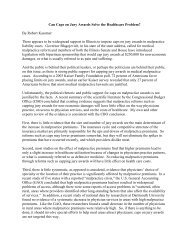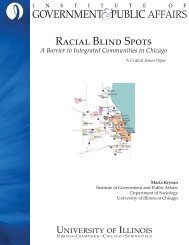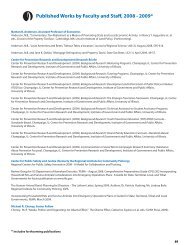Declining Housing Prices and Property Taxes - Institute of ...
Declining Housing Prices and Property Taxes - Institute of ...
Declining Housing Prices and Property Taxes - Institute of ...
- No tags were found...
Create successful ePaper yourself
Turn your PDF publications into a flip-book with our unique Google optimized e-Paper software.
The Illinois Report 201111Dye, Richard F.,Daniel P. McMillen,<strong>and</strong> David F.Merriman, “TheEffect <strong>of</strong> <strong>Declining</strong>House <strong>Prices</strong> onSchool <strong>Property</strong><strong>Taxes</strong> <strong>and</strong> SchoolAid in Illinois,”University <strong>of</strong> Illinois<strong>Institute</strong> <strong>of</strong>Government <strong>and</strong>Public Affairs(2010).side <strong>of</strong> the city. If tax extensions remainedconstant during time <strong>and</strong> there were nochange in the number <strong>of</strong> properties or themix <strong>of</strong> residential <strong>and</strong> non-residentialproperties <strong>and</strong> assessments accuratelyreflect changes in market value, then taxpayments would increase in the areas <strong>of</strong>the city that are in red relative to the areasshaded in blue. If the red areas also experiencedgreater declines in property valuesafter prices began to decline in 2007, thenthese areas will eventually come to be thebeneficiaries <strong>of</strong> lower tax payments whilethe blue areas may make higher tax paymentseven as their homes drop in value.The Illinois <strong>Property</strong> Tax ExtensionLimitation Law (PTELL)PTELL was first adopted in 1991 by thefive collar counties <strong>of</strong> suburban Chicago. Itwas extended to Cook County in 1994, <strong>and</strong>has since been adopted by another 33counties in the state. PTELL limits thegrowth rate in total property tax to thelesser <strong>of</strong> the rate <strong>of</strong> inflation <strong>and</strong> 5 percent.The limits are implemented by imposing amaximum tax rate for jurisdictions inPTELL areas. Because declining assessmentsmust be accompanied by higher taxrates to keep extensions at their target levels<strong>and</strong> PTELL imposes maximum tax rateson jurisdictions, do falling house pricesnecessarily lead to lower property taxextensions in PTELL jurisdictions?This question is addressed in a recent studyby Dye, McMillen, <strong>and</strong> Merriman. 11 Theanswer to the question is no; althoughPTELL imposes limits on increases in propertytax extensions, the interaction betweenfalling assessments <strong>and</strong> the maximum taxrate imposes no additional constraints ontax extensions. The reason for this somewhatcounter-intuitive result is that themaximum tax rate is not set by law;instead, it varies to allow extensions toreach the same level that would have beenreached if assessments had not changed.An example from the Dye, McMillen, <strong>and</strong>Merriman study captures the essence <strong>of</strong>the rate setting process. The maximum taxrate imposed by PTELL can be written asfollows:Maximum tax rate = {(prior extensions)× (1 + inflation factor)}/(new total taxbase), ortptell =( T last year) * (1+p)B this yearwhere, as before, T represents total taxextensions, B represents the total assessmentbase, <strong>and</strong> t represents the tax rate.The new variable is p, which representsthe inflation factor—the less <strong>of</strong> the rate<strong>of</strong> inflation or 5 percent.In times when assessments are rising,PTELL is implemented by imposing alimit on the tax rate. An example based onone presented in the Dye, McMillen, <strong>and</strong>Merriman study illustrates how PTELLaffects total tax extensions for arepresentative school district in a timewhen assessments are falling. Therepresentative district starts with totalEAV (B) <strong>of</strong> $100 million <strong>and</strong> a tax rate (t)<strong>of</strong> 2.5 percent, a combination that provides$2.5 million in total tax extensions (T).Suppose that assessments fall by 10percent so that the new tax base is $90million instead <strong>of</strong> $100 million. Also,suppose that the overall inflation rate iszero, <strong>and</strong> the district therefore decides toleave tax extensions unchanged from theprevious period. The tax rate then mustrise by exactly the amount that assuresthat the $90 million tax base produces $2.5million in taxes. Thus, the new tax rate inthis non-PTELL district is simply 2.5/90 =2.78 percent, or an increase <strong>of</strong> 0.28percentage points.Suppose that an identical district that issubject to PTELL also began with a $100million tax base, a tax rate <strong>of</strong> 2.5 percent,<strong>and</strong> total tax extensions <strong>of</strong> $2.5 million. Ifthe district’s maximum rate remained at2.5 percent, then tax revenue would fall to














